Springboot 整合 RabbitMq ,用心看完这一篇就够了
//Direct 交换机 起名:TestDirectExchange
@Bean
DirectExchange TestDirectExchange() {
// return new DirectExchange("TestDirectExchange",true,true);
return new DirectExchange("TestDirectExchange",true,false);
}
//绑定 将队列和交换机绑定, 并设置用于匹配键:TestDirectRouting
@Bean
Binding bindingDirect() {
return BindingBuilder.bind(TestDirectQueue()).to(TestDirectExchange()).with("TestDirectRouting");
}
@Bean
DirectExchange lonelyDirectExchange() {
return new DirectExchange("lonelyDirectExchange");
}
}
然后写个简单的接口进行消息推送(根据需求也可以改为定时任务等等,具体看需求),SendMessageController.java:
import org.springframework.amqp.rabbit.core.RabbitTemplate;
import org.springframework.beans.factory.annotation.Autowired;
import org.springframework.web.bind.annotation.GetMapping;
import org.springframework.web.bind.annotation.RestController;
import java.time.LocalDateTime;
import java.time.format.DateTimeFormatter;
import java.util.HashMap;
import java.util.Map;
import java.util.UUID;
/**
@Author : JCccc
@CreateTime : 2019/9/3
@Description :
**/
@RestController
public class SendMessageController {
@Autowired
RabbitTemplate rabbitTemplate; //使用 RabbitTemplate,这提供了接收/发送等等方法
@GetMapping("/sendDirectMessage")
public String sendDirectMessage() {
String messageId = String.valueOf(UUID.randomUUID());
String messageData = "test message, hello!";
String createTime = LocalDateTime.now().format(DateTimeFormatter.ofPattern("yyyy-MM-dd HH:mm:ss"));
Map<String,Object> map=new HashMap<>();
map.put("messageId",messageId);
map.put("messageData",messageData);
map.put("createTime",createTime);
//将消息携带绑定键值:TestDirectRouting 发送到交换机 TestDirectExchange
rabbitTemplate.convertAndSend("TestDirectExchange", "TestDirectRouting", map);
return "ok";
}
}
把 rabbitmq-provider 项目运行,调用下接口:
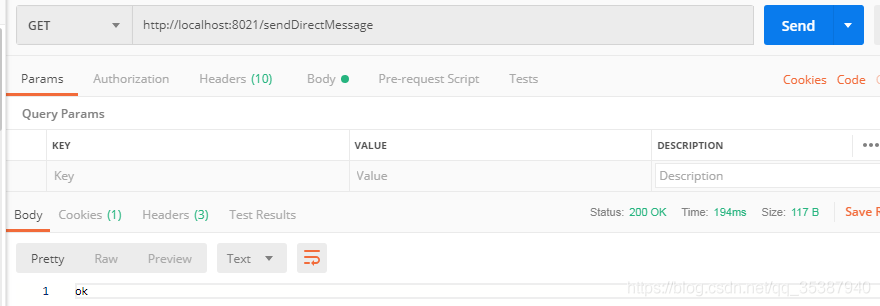
因为我们目前还没弄消费者?rabbitmq-consumer,消息没有被消费的,我们去 rabbitMq 管理页面看看,是否推送成功:
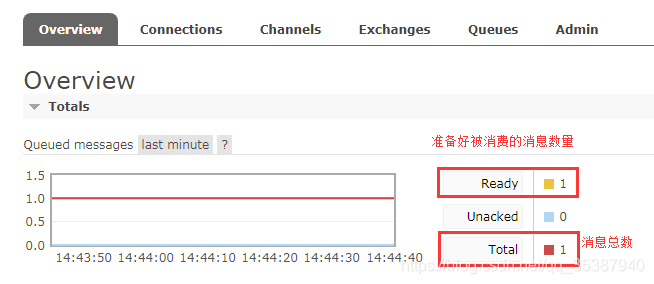
再看看队列(界面上的各个英文项代表什么意思,可以自己查查哈,对理解还是有帮助的):
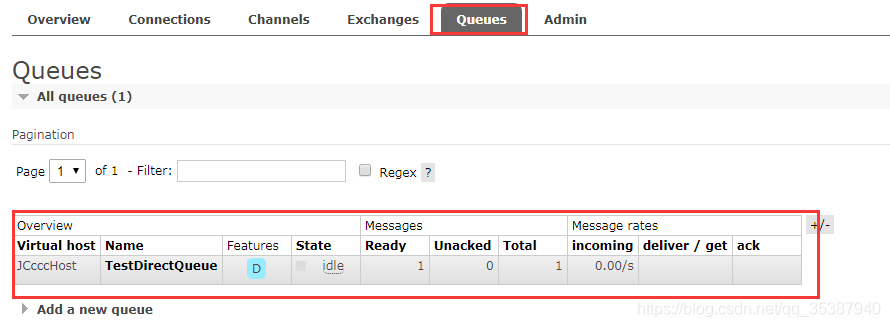
很好,消息已经推送到 rabbitMq 服务器上面了。
接下来,创建 rabbitmq-consumer 项目:
pom.xml 里的 jar 依赖:
<dependency>
<groupId>org.springframework.boot</groupId>
<artifactId>spring-boot-starter-amqp</artifactId>
</dependency>
<dependency>
<groupId>org.springframework.boot</groupId>
<artifactId>spring-boot-starter</artifactId>
</dependency>
然后是?application.yml:
server:
port: 8022
spring:
#给项目来个名字
application:
name: rabbitmq-consumer
#配置 rabbitMq 服务器
rabbitmq:
host: 127.0.0.1
port: 5672
username: root
password: root
#虚拟 host 可以不设置,使用 server 默认 host
virtual-host: JCcccHost
然后一样,创建 DirectRabbitConfig.java(消费者单纯的使用,其实可以不用添加这个配置,直接建后面的监听就好,使用注解来让监听器监听对应的队列即可。配置上了的话,其实消费者也是生成者的身份,也能推送该消息。):
import org.springframework.amqp.core.Binding;
import org.springframework.amqp.core.BindingBuilder;
import org.springframework.amqp.core.DirectExchange;
import org.springframework.amqp.core.Queue;
import org.springframework.context.annotation.Bean;
import org.springframework.context.annotation.Configuration;
/**
@Author : JCccc
@CreateTime : 2019/9/3
@Description :
**/
@Configuration
public class DirectRabbitConfig {
//队列 起名:TestDirectQueue
@Bean
public Queue TestDirectQueue() {
return new Queue("TestDirectQueue",true);
}
//Direct 交换机 起名:TestDirectExchange
@Bean
DirectExchange TestDirectExchange() {
return new DirectExchange("TestDirectExchange");
}
//绑定 将队列和交换机绑定, 并设置用于匹配键:TestDirectRouting
@Bean
Binding bindingDirect() {
return BindingBuilder.bind(TestDirectQueue()).to(TestDirectExchange()).with("TestDirectRouting");
}
}
然后是创建消息接收监听类,DirectReceiver.java:
@Component
@RabbitListener(queues = "TestDirectQueue")//监听的队列名称 TestDirectQueue
public class DirectReceiver {
@RabbitHandler
public void process(Map testMessage) {
System.out.println("DirectReceiver 消费者收到消息 : " + testMessage.toString());
}
}
然后将 rabbitmq-consumer 项目运行起来,可以看到把之前推送的那条消息消费下来了:

然后可以再继续调用 rabbitmq-provider 项目的推送消息接口,可以看到消费者即时消费消息:

那么直连交换机既然是一对一,那如果咱们配置多台监听绑定到同一个直连交互的同一个队列,会怎么样?
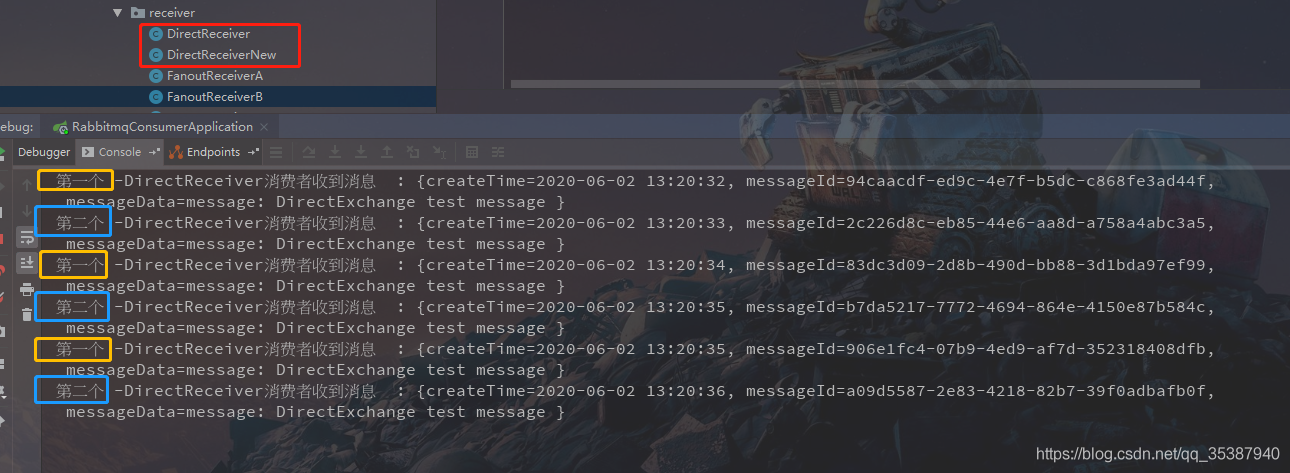
可以看到是实现了轮询的方式对消息进行消费,而且不存在重复消费。
接着,我们使用 Topic Exchange 主题交换机。
在 rabbitmq-provider 项目里面创建 TopicRabbitConfig.java:
import org.springframework.amqp.core.Binding;
import org.springframework.amqp.core.BindingBuilder;
import org.springframework.amqp.core.Queue;
import org.springframework.amqp.core.TopicExchange;
import org.springframework.context.annotation.Bean;
import org.springframework.context.annotation.Configuration;
/**
@Author : JCccc
@CreateTime : 2019/9/3
@Description :
**/
@Configuration
public class TopicRabbitConfig {
//绑定键
public final static String man = "topic.man";
public final static String woman = "topic.woman";
@Bean
public Queue firstQueue() {
return new Queue(TopicRabbitConfig.man);
}
@Bean
public Queue secondQueue() {
return new Queue(TopicRabbitConfig.woman);
}
@Bean
TopicExchange exchange() {
return new TopicExchange("topicExchange");
}
//将 firstQueue 和 topicExchange 绑定,而且绑定的键值为 topic.man
//这样只要是消息携带的路由键是 topic.man,才会分发到该队列
@Bean
Binding bindingExchangeMessage() {
return BindingBuilder.bind(firstQueue()).to(exchange()).with(man);
}
//将 secondQueue 和 topicExchange 绑定,而且绑定的键值为用上通配路由键规则 topic.#
// 这样只要是消息携带的路由键是以 topic.开头,都会分发到该队列
@Bean
Binding bindingExchangeMessage2() {
return BindingBuilder.bind(secondQueue()).to(exchange()).with("topic.#");
}
}
然后添加多 2 个接口,用于推送消息到主题交换机:
@GetMapping("/sendTopicMessage1")
public String sendTopicMessage1() {
String messageId = String.valueOf(UUID.randomUUID());
String messageData = "message: M A N ";
String createTime = LocalDateTime.now().format(DateTimeFormatter.ofPattern("yyyy-MM-dd HH:mm:ss"));
Map<String, Object> manMap = new HashMap<>();
manMap.put("messageId", messageId);
manMap.put("messageData", messageData);
manMap.put("createTime", createTime);
rabbitTemplate.convertAndSend("topicExchange", "topic.man", manMap);
return "ok";
}
@GetMapping("/sendTopicMessage2")
public String sendTopicMessage2() {
String messageId = String.valueOf(UUID.randomUUID());
String messageData = "message: woman is all ";
String createTime = LocalDateTime.now().format(DateTimeFormatter.ofPattern("yyyy-MM-dd HH:mm:ss"));
Map<String, Object> womanMap = new HashMap<>();
womanMap.put("messageId", messageId);
womanMap.put("messageData", messageData);
womanMap.put("createTime", createTime);
rabbitTemplate.convertAndSend("topicExchange", "topic.woman", womanMap);
return "ok";
}
}
生产者这边已经完事,先不急着运行,在 rabbitmq-consumer 项目上,创建 TopicManReceiver.java:
import org.springframework.amqp.rabbit.annotation.RabbitHandler;
import org.springframework.amqp.rabbit.annotation.RabbitListener;
import org.springframework.stereotype.Component;
import java.util.Map;
/**
@Author : JCccc
@CreateTime : 2019/9/3
@Description :
**/
@Component
@RabbitListener(queues = "topic.man")
public class TopicManReceiver {
@RabbitHandler
public void process(Map testMessage) {
System.out.println("TopicManReceiver 消费者收到消息 : " + testMessage.toString());
}
}
再创建一个 TopicTotalReceiver.java:
package com.elegant.rabbitmqconsumer.receiver;
import org.springframework.amqp.rabbit.annotation.RabbitHandler;
import org.springframework.amqp.rabbit.annotation.RabbitListener;
import org.springframework.stereotype.Component;
import java.util.Map;
/**
@Author : JCccc
@CreateTime : 2019/9/3
@Description :
**/
@Component
@RabbitListener(queues = "topic.woman")
public class TopicTotalReceiver {
@RabbitHandler
public void process(Map testMessage) {
System.out.println("TopicTotalReceiver 消费者收到消息 : " + testMessage.toString());
}
}
同样,加主题交换机的相关配置,TopicRabbitConfig.java(消费者一定要加这个配置吗? 不需要的其实,理由在前面已经说过了。):
import org.springframework.amqp.core.Binding;
import org.springframework.amqp.core.BindingBuilder;
import org.springframework.amqp.core.Queue;
import org.springframework.amqp.core.TopicExchange;
import org.springframework.context.annotation.Bean;
import org.springframework.context.annotation.Configuration;
/**
@Author : JCccc
@CreateTime : 2019/9/3
@Description :
**/
@Configuration
public class TopicRabbitConfig {
//绑定键
public final static String man = "topic.man";
public final static String woman = "topic.woman";
@Bean
public Queue firstQueue() {
return new Queue(TopicRabbitConfig.man);
}
@Bean
public Queue secondQueue() {
return new Queue(TopicRabbitConfig.woman);
}
@Bean
TopicExchange exchange() {
return new TopicExchange("topicExchange");
}
//将 firstQueue 和 topicExchange 绑定,而且绑定的键值为 topic.man
//这样只要是消息携带的路由键是 topic.man,才会分发到该队列
@Bean
Binding bindingExchangeMessage() {
return BindingBuilder.bind(firstQueue()).to(exchange()).with(man);
}
//将 secondQueue 和 topicExchange 绑定,而且绑定的键值为用上通配路由键规则 topic.#
// 这样只要是消息携带的路由键是以 topic.开头,都会分发到该队列
@Bean
Binding bindingExchangeMessage2() {
return BindingBuilder.bind(secondQueue()).to(exchange()).with("topic.#");
}
}
然后把 rabbitmq-provider,rabbitmq-consumer 两个项目都跑起来,先调用/sendTopicMessage1? 接口:
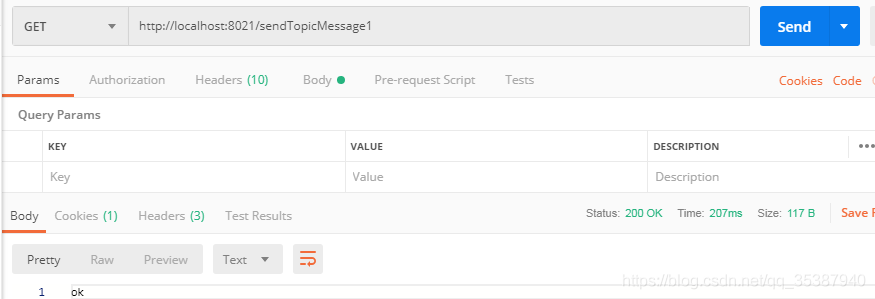
然后看消费者 rabbitmq-consumer 的控制台输出情况:
TopicManReceiver 监听队列 1,绑定键为:topic.man
TopicTotalReceiver 监听队列 2,绑定键为:topic.#
而当前推送的消息,携带的路由键为:topic.man??
所以可以看到两个监听消费者 receiver 都成功消费到了消息,因为这两个 recevier 监听的队列的绑定键都能与这条消息携带的路由键匹配上。

接下来调用接口/sendTopicMessage2:
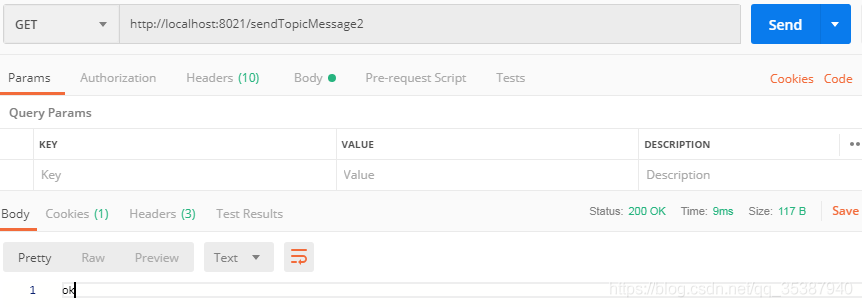
然后看消费者 rabbitmq-consumer 的控制台输出情况:
TopicManReceiver 监听队列 1,绑定键为:topic.man
TopicTotalReceiver 监听队列 2,绑定键为:topic.#
而当前推送的消息,携带的路由键为:topic.woman
所以可以看到两个监听消费者只有 TopicTotalReceiver 成功消费到了消息。

接下来是使用 Fanout Exchang 扇型交换机。
同样地,先在 rabbitmq-provider 项目上创建 FanoutRabbitConfig.java:
import org.springframework.amqp.core.Binding;
import org.springframework.amqp.core.BindingBuilder;
import org.springframework.amqp.core.FanoutExchange;
import org.springframework.amqp.core.Queue;
import org.springframework.context.annotation.Bean;
import org.springframework.context.annotation.Configuration;
/**
@Author : JCccc
@CreateTime : 2019/9/3
@Description :
**/
@Configuration
public class FanoutRabbitConfig {
/**
创建三个队列 :fanout.A fanout.B fanout.C
将三个队列都绑定在交换机 fanoutExchange 上
因为是扇型交换机, 路由键无需配置,配置也不起作用
*/
@Bean
public Queue queueA() {
return new Queue("fanout.A");
}
@Bean
public Queue queueB() {
return new Queue("fanout.B");
}
@Bean
public Queue queueC() {
return new Queue("fanout.C");
}
@Bean
FanoutExchange fanoutExchange() {
return new FanoutExchange("fanoutExchange");
}
@Bean
Binding bindingExchangeA() {
return BindingBuilder.bind(queueA()).to(fanoutExchange());
}
@Bean
Binding bindingExchangeB() {
return BindingBuilder.bind(queueB()).to(fanoutExchange());
}
@Bean
Binding bindingExchangeC() {
return BindingBuilder.bind(queueC()).to(fanoutExchange());
}
}
然后是写一个接口用于推送消息,
@GetMapping("/sendFanoutMessage")
public String sendFanoutMessage() {
String messageId = String.valueOf(UUID.randomUUID());
String messageData = "message: testFanoutMessage ";
String createTime = LocalDateTime.now().format(DateTimeFormatter.ofPattern("yyyy-MM-dd HH:mm:ss"));
Map<String, Object> map = new HashMap<>();
map.put("messageId", messageId);
map.put("messageData", messageData);
map.put("createTime", createTime);
rabbitTemplate.convertAndSend("fanoutExchange", null, map);
return "ok";
}
接着在 rabbitmq-consumer 项目里加上消息消费类,
FanoutReceiverA.java:
import org.springframework.amqp.rabbit.annotation.RabbitHandler;
import org.springframework.amqp.rabbit.annotation.RabbitListener;
import org.springframework.stereotype.Component;
import java.util.Map;
/**
@Author : JCccc
@CreateTime : 2019/9/3
@Description :
**/
@Component
@RabbitListener(queues = "fanout.A")
public class FanoutReceiverA {
@RabbitHandler
public void process(Map testMessage) {
System.out.println("FanoutReceiverA 消费者收到消息 : " +testMessage.toString());
}
}
FanoutReceiverB.java:
import org.springframework.amqp.rabbit.annotation.RabbitHandler;
import org.springframework.amqp.rabbit.annotation.RabbitListener;
impo
rt org.springframework.stereotype.Component;
import java.util.Map;
/**
@Author : JCccc
@CreateTime : 2019/9/3
@Description :
**/
@Component
@RabbitListener(queues = "fanout.B")
public class FanoutReceiverB {
@RabbitHandler
public void process(Map testMessage) {
System.out.println("FanoutReceiverB 消费者收到消息 : " +testMessage.toString());
}
}
FanoutReceiverC.java:
import org.springframework.amqp.rabbit.annotation.RabbitHandler;
import org.springframework.amqp.rabbit.annotation.RabbitListener;
import org.springframework.stereotype.Component;
import java.util.Map;
/**
@Author : JCccc
@CreateTime : 2019/9/3
@Description :
**/
@Component
@RabbitListener(queues = "fanout.C")
public class FanoutReceiverC {
@RabbitHandler
public void process(Map testMessage) {
System.out.println("FanoutReceiverC 消费者收到消息 : " +testMessage.toString());
}
}
然后加上扇型交换机的配置类,FanoutRabbitConfig.java(消费者真的要加这个配置吗? 不需要的其实,理由在前面已经说过了):
import org.springframework.amqp.core.Binding;
import org.springframework.amqp.core.BindingBuilder;
import org.springframework.amqp.core.FanoutExchange;
import org.springframework.amqp.core.Queue;
import org.springframework.context.annotation.Bean;
import org.springframework.context.annotation.Configuration;
/**
@Author : JCccc
@CreateTime : 2019/9/3
@Description :
**/
@Configuration
public class FanoutRabbitConfig {
/**
创建三个队列 :fanout.A fanout.B fanout.C
将三个队列都绑定在交换机 fanoutExchange 上
因为是扇型交换机, 路由键无需配置,配置也不起作用
*/
@Bean
public Queue queueA() {
return new Queue("fanout.A");
}
@Bean
public Queue queueB() {
return new Queue("fanout.B");
}
@Bean
public Queue queueC() {
return new Queue("fanout.C");
}
@Bean
FanoutExchange fanoutExchange() {
return new FanoutExchange("fanoutExchange");
}
@Bean
Binding bindingExchangeA() {
return BindingBuilder.bind(queueA()).to(fanoutExchange());
}
@Bean
Binding bindingExchangeB() {
return BindingBuilder.bind(queueB()).to(fanoutExchange());
}
@Bean
Binding bindingExchangeC() {
return BindingBuilder.bind(queueC()).to(fanoutExchange());
}
}
最后将 rabbitmq-provider 和 rabbitmq-consumer 项目都跑起来,调用下接口/sendFanoutMessage :
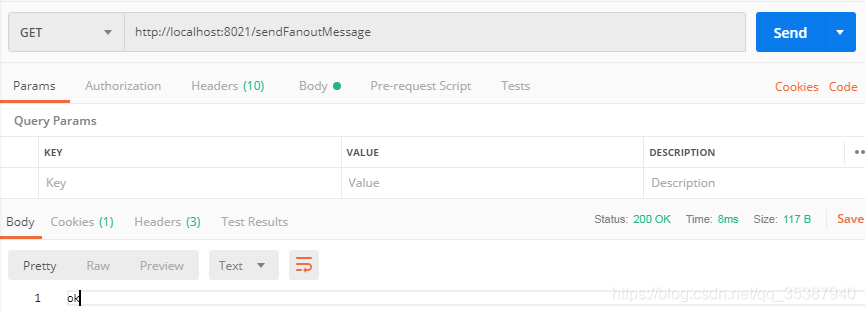
然后看看 rabbitmq-consumer 项目的控制台情况:

可以看到只要发送到?fanoutExchange 这个扇型交换机的消息, 三个队列都绑定这个交换机,所以三个消息接收类都监听到了这条消息。
到了这里其实三个常用的交换机的使用我们已经完毕了,那么接下来我们继续讲讲消息的回调,其实就是消息确认(生产者推送消息成功,消费者接收消息成功)。
在 rabbitmq-provider 项目的 application.yml 文件上,加上消息确认的配置项后:
ps: 本篇文章使用 springboot 版本为?2.1.7.RELEASE ;?
如果你们在配置确认回调,测试发现无法触发回调函数,那么存在原因也许是因为版本导致的配置项不起效,
可以把 publisher-confirms:?true 替换为? publisher-confirm-type: correlated
server:
port: 8021
spring:
#给项目来个名字
application:
name: rabbitmq-provider
#配置 rabbitMq 服务器
rabbitmq:
host: 127.0.0.1
port: 5672
username: root
password: root
#虚拟 host 可以不设置,使用 server 默认 host
virtual-host: JCcccHost
#消息确认配置项
#确认消息已发送到交换机(Exchange)
publisher-confirms: true
#确认消息已发送到队列(Queue)
publisher-returns: true
然后是配置相关的消息确认回调函数,RabbitConfig.java:
import org.springframework.amqp.core.Message;
import org.springframework.amqp.rabbit.connection.ConnectionFactory;
import org.springframework.amqp.rabbit.connection.CorrelationData;
import org.springframework.amqp.rabbit.core.RabbitTemplate;
import org.springframework.context.annotation.Bean;
import org.springframework.context.annotation.Configuration;
/**
@Author : JCccc
@CreateTime : 2019/9/3
@Description :
**/
@Configuration
public class RabbitConfig {
@Bean
public RabbitTemplate createRabbitTemplate(ConnectionFactory connectionFactory){
RabbitTemplate rabbitTemplate = new RabbitTemplate();
rabbitTemplate.setConnectionFactory(connectionFactory);
//设置开启 Mandatory,才能触发回调函数,无论消息推送结果怎么样都强制调用回调函数
rabbitTemplate.setMandatory(true);
rabbitTemplate.setConfirmCallback(new RabbitTemplate.ConfirmCallback() {
@Override
public void confirm(CorrelationData correlationData, boolean ack, String cause) {
System.out.println("ConfirmCallback: "+"相关数据:"+correlationData);
System.out.println("ConfirmCallback: "+"确认情况:"+ack);
System.out.println("ConfirmCallback: "+"原因:"+cause);
}
});
rabbitTemplate.setReturnCallback(new RabbitTemplate.ReturnCallback() {
@Override
public void returnedMessage(Message message, int replyCode, String replyText, String exchange, String routingKey) {
System.out.println("ReturnCallback: "+"消息:"+message);
System.out.println("ReturnCallback: "+"回应码:"+replyCode);
System.out.println("ReturnCallback: "+"回应信息:"+replyText);
System.out.println("ReturnCallback: "+"交换机:"+exchange);
System.out.println("ReturnCallback: "+"路由键:"+routingKey);
}
});
return rabbitTemplate;
}
}
到这里,生产者推送消息的消息确认调用回调函数已经完毕。
可以看到上面写了两个回调函数,一个叫 ConfirmCallback ,一个叫 RetrunCallback;
那么以上这两种回调函数都是在什么情况会触发呢?
先从总体的情况分析,推送消息存在四种情况:
①消息推送到 server,但是在 server 里找不到交换机
②消息推送到 server,找到交换机了,但是没找到队列
③消息推送到 sever,交换机和队列啥都没找到
④消息推送成功
那么我先写几个接口来分别测试和认证下以上 4 种情况,消息确认触发回调函数的情况:
①消息推送到 server,但是在 server 里找不到交换机
写个测试接口,把消息推送到名为‘non-existent-exchange’的交换机上(这个交换机是没有创建没有配置的):
@GetMapping("/TestMessageAck")
public String TestMessageAck() {
String messageId = String.valueOf(UUID.randomUUID());
String messageData = "message: non-existent-exchange test message ";
String createTime = LocalDateTime.now().format(DateTimeFormatter.ofPattern("yyyy-MM-dd HH:mm:ss"));
Map<String, Object> map = new HashMap<>();
map.put("messageId", messageId);
map.put("messageData", messageData);
map.put("createTime", createTime);
rabbitTemplate.convertAndSend("non-existent-exchange", "TestDirectRouting", map);
return "ok";
}
调用接口,查看 rabbitmq-provuder 项目的控制台输出情况(原因里面有说,没有找到交换机'non-existent-exchange'):
2019-09-04 09:37:45.197 ERROR 8172 --- [ 127.0.0.1:5672] o.s.a.r.c.CachingConnectionFactory : Channel shutdown: channel error; protocol method: #method<channel.close>(reply-code=404, reply-text=NOT_FOUND - no exchange 'non-existent-exchange' in vhost 'JCcccHost', class-id=60, method-id=40)
ConfirmCallback: 相关数据:null
ConfirmCallback: 确认情况:false
ConfirmCallback: 原因:channel error; protocol method: #method<channel.close>(reply-code=404, reply-text=NOT_FOUND - no exchange 'non-existent-exchange' in vhost 'JCcccHost', class-id=60, method-id=40)
结论: ①这种情况触发的是?ConfirmCallback 回调函数。
②消息推送到 server,找到交换机了,但是没找到队列??
这种情况就是需要新增一个交换机,但是不给这个交换机绑定队列,我来简单地在 DirectRabitConfig 里面新增一个直连交换机,名叫‘lonelyDirectExchange’,但没给它做任何绑定配置操作:
@Bean
DirectExchange lonelyDirectExchange() {
return new DirectExchange("lonelyDirectExchange");
}
然后写个测试接口,把消息推送到名为‘lonelyDirectExchange’的交换机上(这个交换机是没有任何队列配置的):
@GetMapping("/TestMessageAck2")
public String TestMessageAck2() {
String messageId = String.valueOf(UUID.randomUUID());
String messageData = "message: lonelyDirectExchange test message ";
String createTime = LocalDateTime.now().format(DateTimeFormatter.ofPattern("yyyy-MM-dd HH:mm:ss"));
Map<String, Object> map = new HashMap<>();
map.put("messageId", messageId);
map.put("messageData", messageData);
map.put("createTime", createTime);
rabbitTemplate.convertAndSend("lonelyDirectExchange", "TestDirectRouting", map);
return "ok";
}
调用接口,查看 rabbitmq-provuder 项目的控制台输出情况:
ReturnCallback: 消息:(Body:'{createTime=2019-09-04 09:48:01, messageId=563077d9-0a77-4c27-8794-ecfb183eac80, messageData=message: lonelyDirectExchange test message }' MessageProperties [headers={}, contentType=application/x-java-serialized-object, contentLength=0, receivedDeliveryMode=PERSISTENT, priority=0, deliveryTag=0])
ReturnCallback: 回应码:312
ReturnCallback: 回应信息:NO_ROUTE
ReturnCallback: 交换机:lonelyDirectExchange
ReturnCallback: 路由键:TestDirectRouting
ConfirmCallback: 相关数据:null
ConfirmCallback: 确认情况:true
ConfirmCallback: 原因:null
可以看到这种情况,两个函数都被调用了;
这种情况下,消息是推送成功到服务器了的,所以 ConfirmCallback 对消息确认情况是 true;
而在 RetrunCallback 回调函数的打印参数里面可以看到,消息是推送到了交换机成功了,但是在路由分发给队列的时候,找不到队列,所以报了错误 NO_ROUTE 。
结论:②这种情况触发的是?ConfirmCallback 和 RetrunCallback 两个回调函数。
③消息推送到 sever,交换机和队列啥都没找到?
这种情况其实一看就觉得跟①很像,没错 ,③和①情况回调是一致的,所以不做结果说明了。
结论: ③这种情况触发的是?ConfirmCallback 回调函数。
④消息推送成功
那么测试下,按照正常调用之前消息推送的接口就行,就调用下 /sendFanoutMessage 接口,可以看到控制台输出:
ConfirmCallback: 相关数据:null
ConfirmCallback: 确认情况:true
ConfirmCallback: 原因:null
结论: ④这种情况触发的是?ConfirmCallback 回调函数。
以上是生产者推送消息的消息确认 回调函数的使用介绍(可以在回调函数根据需求做对应的扩展或者业务数据处理)。












评论